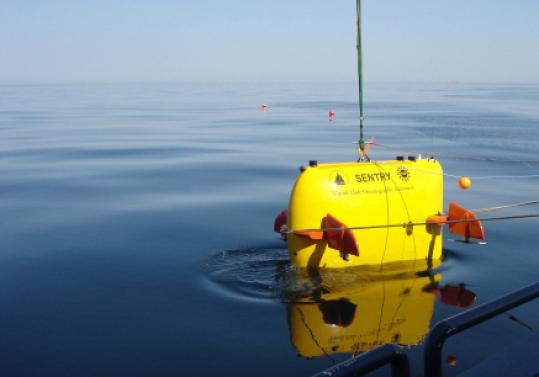
Woods Hole’s Sentry searched for underwater plumes in the gulf. (Woods Hole Oceanographic Institution)
Study foretold a consequence of oil leak

Woods Hole’s Sentry searched for underwater plumes in the gulf. (Woods Hole Oceanographic Institution)
It wasn’t until seven weeks after the BP oil well began gushing that the company acknowledged oil remained hidden under the surface of the Gulf of Mexico, and it continues to dispute the extent of miles-long submerged plumes. But an unusual experiment conducted in 2000 off the coast of Norway,
a trial run of a deep-water oil and gas spill that BP helped pay for,
showed that oil could remain underwater for some time.
A research cruise headed by Woods Hole Oceanographic Institution
researchers and funded by the National Science Foundation set out
Thursday to map one of the cloudy mixtures and dissect its
components to better understand its toxicity, where it might travel,
and how quickly it is being broken down by oil-eating microbes.
There are other concerns. Scientists say the high pressure of the gushing leak is creating tiny oil droplets, some that can become suspended in water. The use of large amounts of underwater chemical dispersants are making those droplets smaller still. All those droplets, suspended in the water and trapped by dense ocean layers, are probably forming the plumes. Scientists are also concerned about how much gas from the gushing well remains trapped underwater.
The use of dispersants is continuing, because scientists believe
they help natural forces more easily break down the oil into less
toxic compounds. Oil-eating microbes will do that under water. On
the surface, they will be aided by sunlight, waves, and weather.
But it’s a careful balance. If there are too many oil droplets in
the water, the microbes, which need oxygen, could grow out of
control and suck up so much oxygen they create a dead zone. Samantha
Joye, a University of Georgia scientist who was one of the first to
discover the undersea oil, said oxygen levels were down 30 percent
or more in some areas she sampled. Federal officials say ongoing
testing shows oxygen levels in the gulf are normal.
“But there is a tipping point . . . that’s why you need continuous
monitoring,’’ and NOAA is doing that, said Murawski, of the
Fisheries Service.
The Deep Spill experiment, some 200 miles off Norway’s coast, was
celebrated at the time as a forward-looking exercise for the next
generation of drilling.
In all, four mixtures were released, including a combination of
diesel oil and natural gas that, while not a perfect parallel to the
crude oil leaking in the gulf, gives some comparison. Flow rates
were comparable to the Gulf spill rate. No dispersants were used.
According to a 2005 analysis by MIT’s Adams and Scott Socolofsky,
now a professor at Texas A&M University, between 2 and 17 cubic
meters of the 60 cubic meters of released diesel made it to the
surface before overflights looking for oil on the sea surface ended,
about seven hours after the oil release stopped.
The scientists suggested that a significant portion of the oil rose
slowly because it was comprised of very small droplets. Another
colleague, Stephen Masutani of the University of Hawaii, found that
one-third of the oil in Deep Spill would probably be found in
droplets of half a millimeter or smaller, which could have taken a
day or more to surface.
In the gulf spill, the dispersants probably made droplets much
smaller still, Adams said, which means they could take much longer
to surface.
Those droplets can get trapped by currents and dense water layers
deep in the sea. “These small droplets have no choice but to follow
the water once it leaves the upward-rising oil-and-gas mixture,’’
Socolofsky said.
After Deep Spill, there was no effort by the industry — or
government — to better understand these submerged oil droplets.
Beth Daley can be reached at
bdaley@globe.com.
© Copyright 2010 Globe Newspaper Company
|